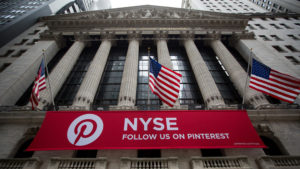 Pinterest joins dual-class bandwagon but with a twist.
Pinterest joins dual-class bandwagon but with a twist.
Pinterest Inc. filed its first round of its much-anticipated initial public offering documents on Friday, after the market closed, and the 184-plus page S-1 had a surprise or two about the online image discovery company.
The company, which appears to be attempting the sunset version of dual-class stock, is expected to go public as soon as April, according to The Wall Street Journal, and it was last valued at about $12 billion as a private company.
The San Francisco-based company tried to explain itself to Wall Street, where some investors might still not understand what the company does, but it was not able to come up with something succinct or catchy such as online scrapbooking site, or an online image discovery engine.
What is Pinterest?
Instead, the company said: “Pinterest is where more than 250 million people around the world go to get inspiration for their lives. They come to discover ideas for just about anything you can imagine: daily activities like cooking dinner or deciding what to wear, major commitments like remodeling a house or training for a marathon, ongoing passions like fly fishing or fashion and milestone events like planning a wedding or a dream vacation.”
Pinterest said it calls its users “Pinners” and it has an apt stock symbol: PINS, and it plans to be listed on the New York Stock Exchange. “We show them visual recommendations, which we call Pins, based on their personal taste and interests,” Pinterest said. “They then save and organize these recommendations into collections, called boards.”
Yes, it really is mostly used by women
Pinterest said that its users are about two-thirds women. It also had another interesting description of its demographics. “In the United States, our total audience includes 43% of internet users, which includes approximately 80% of women ages 18-64 with children, according to an independent study by Comscore.” In its risk factors, Pinterest said that it “may not be able to penetrate certain demographics in a meaningful manner to grow the number of Pinners.”
Selling ads is now making money in the fourth quarter
The company surprisingly had two profitable fourth quarters, but with two full years of losses. In the most recent fourth quarter, Pinterest said it had revenue of $273 million in the fourth quarter and net income of $47 million, compared with revenue of $173.3 million, and a net income of $3.4 million.
Its full-year 2018 revenue surged 60% to $755.9 million, up from $472.8 million in 2017. Costs grew, but with stronger revenue in 2018, it was able to narrow its 2018 losses by half, and reported a net loss of $63 million, or 17 cents a share, down from a net loss of $130 million, or 34 cents a share, in 2017. The company only began selling advertising on its site in 2014, and it only began to expand outside the U.S. in 2016, describing these approaches as similarly deliberate.
Fixed cloud computing costs
Last year, Pinterest said it amended its agreement with Amazon’s AMZN, -0.13% Web Services, so that it will have to purchase at least $750 million in cloud services from AWS through July 2023. It was also required to purchase at least $125 million (its initial commitment) of services through June 2018. If it fails to meet its commitment, it is required to pay the difference. As of December, Pinterest had fulfilled its initial commitment with Amazon, and expects to meet its remaining commitment.
Pinterest joins the dual-class bandwagon, but with a twist
In a not so surprising statement, Pinterest, like many other tech companies in recent years, is going to have dual-class shares, a popular option in Silicon Valley, which worships founder control. However, Pinterest offered a more corporate governance friendly version of dual-class stock, which typically gives two or three company founders complete control of their companies into perpetuity.
Pinterest will create two classes of stock, a Class A common stock that will be sold at its IPO, and a Class B common stock, that is owned by company co-founder Ben Silbermann, president and chief executive, and several other executives and early investors. The company has not yet specified what percentage of voting power the Class B shares will have, but the interesting twist is that the voting control will have a time limit, an option that has been referred to as a sunset option.
However, it’s still possible that this dual-class structure will still give voting control to Silbermann, but it is not yet clear. Pinterest said in its filing that all of its Class B common stock will convert into class A shares seven years after the IPO, with the exception of shares owned by anyone who still owns at least 50% of Class B. The shares will also convert to class A, after the death or incapacity of Silbermann, at a date determined by the board.
Another interesting element is that Pinterest co-founder Evan Sharp, who is listed as chief design and creative officer, is not an executive officer of the company, nor is he on the board. On Thursday, both Silbermann and Sharp were each issued 7 million restricted stock units, with the conditions that they vest only if certain service based and liquidity conditions are met.
Pinterest is clearly hoping it will appeal to more mainstream investors, with an easier to handle dual-class approach, that does not give its top executives control forever. But since there are still more details to come, including the total amount of funds Pinterest is seeking to raise, investors won’t really know how much more friendly this approach is, until more information is available. For now, it looks like Pinterest is trying to be different.
Want this type of analysis sent to your inbox? Subscribe to MarketWatch’s free MarketWatch First Takes newsletter. Sign up here.